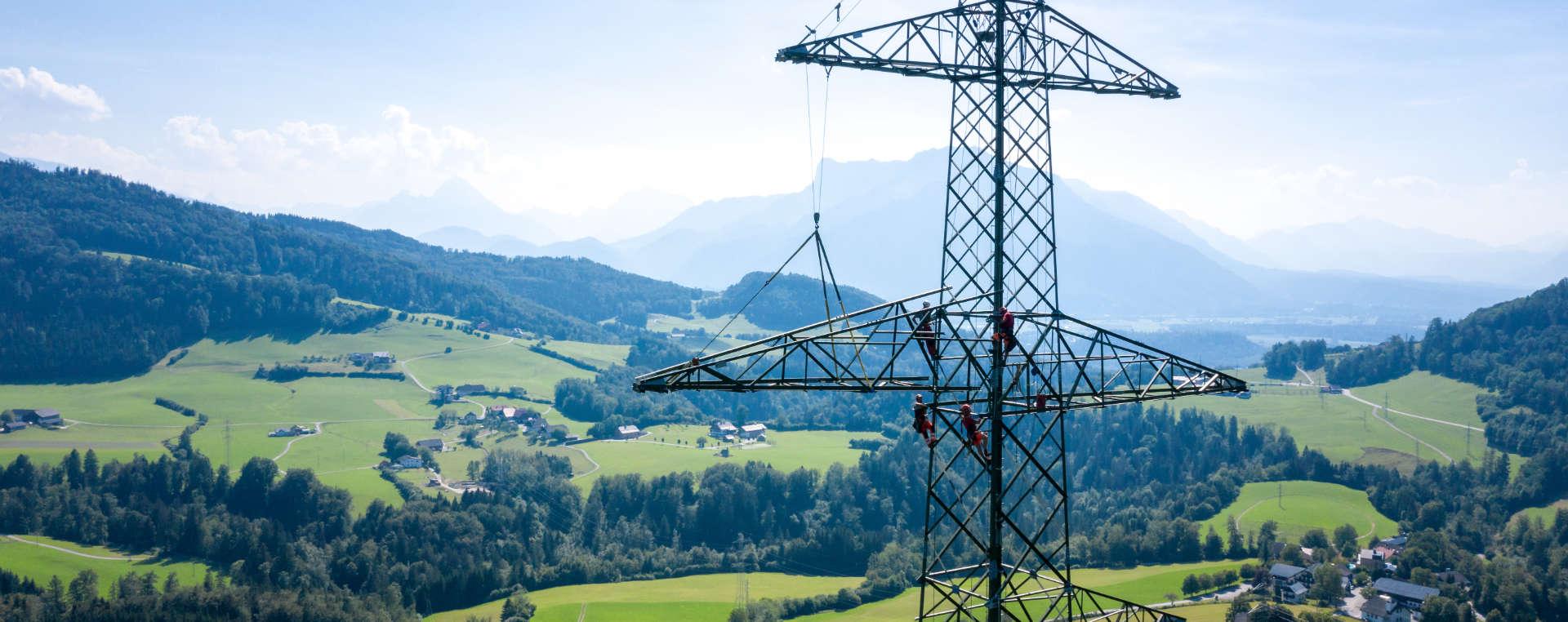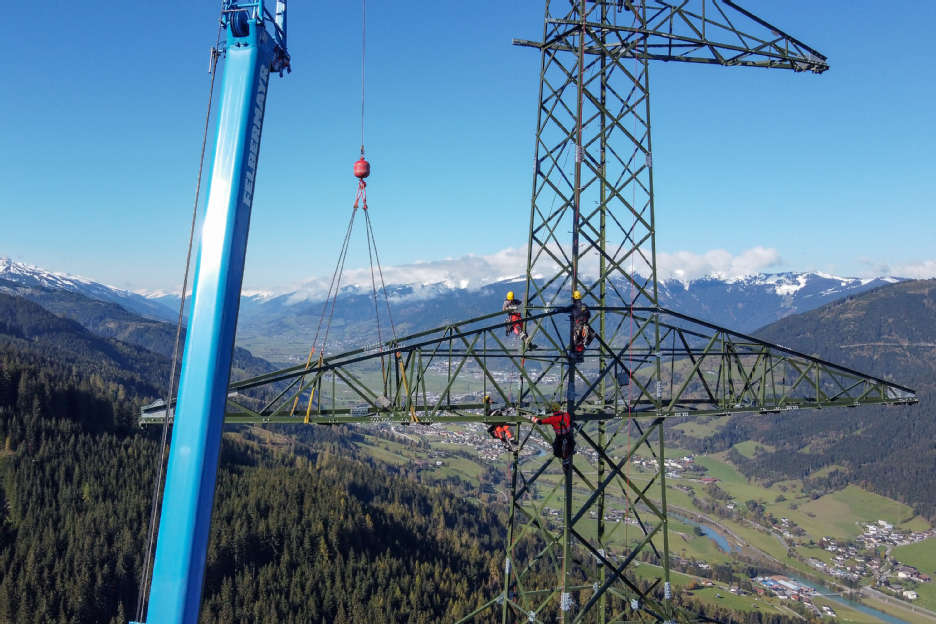
Salzburg line
Once completed, the Salzburg line will ensure energy security for Salzburg and the rest of Austria. The line is also crucial to reaching Austria’s climate targets, which makes it one of the most important infrastructure projects underway today.
Security of supply and sustainable integration of renewable energy.
With the goal of improving security of supply to the city of Salzburg, the first 46-km long section of the Salzburg line extending from the St.?Peter node to the newly built Salzburg substation near Elixhausen was completed ahead of schedule and commissioned in January 2011.
Now that the first section of the line has been completed, the focus is on the second section in order to close the gap on the western side of the “ring”.Austria’s high-performance, extra-high voltage grid is characterised by its ring structure, which allows power to flow to customers from either direction. The 380-kV ring is the backbone of Austria’s electricity supply, and the new section of the Salzburg line will close the gap in the ring in western Austria. The 380-kV Salzburg line will replace the existing 220-kV line from the node at St.?Peter am Hart (Upper Austria) to the Tauern bei Kaprun node (Salzburg).



Project ticker
All current information about the project at a glance.
Project ticker
All current information about the project at a glance.
- Update
Construction progress
The work to complete the Salzburg line is running at full speed. Currently, around 442 of 449 pylons have already been set.
128 km
approx. €1 bill.
449
678
6
36
6.7 km
38 km
Project Roadmap
Dismantling
As soon as the new 380 kV Salzburg line is in operation, the dismantling of the existing 220 kV and 110 kV lines will start. The dismantling is part of the Salzburg line project and has been approved as part of the EIA.
Higher regional court upholds approval for 380-kV line
In its favourable decision of 15 October 2020, which constituted the final ruling on the project, the Higher Regional Court (VwGH) upheld all aspects of the approval notice issued by the government of the State of Salzburg on 14 December 2015 and amended as at 26 February 2019 based on Federal Administrative Court (BVwG) findings.
Start of construction
Start of construction of the Salzburg line
Federal Administrative Court upholds EIA approval notice
Federal Administrative Court confirms positive EIA decision
Initial EIA approval notice issued
Positive EIA decision 1st instance
Project documents submitted to the EIA authorities
Submission of project documents to the EIA authorities
APG is investing in a sustainable and secure energy future in your region. For the economy and society as a whole.
Frequently asked questions - FAQ
Land is generally appropriated either when a pylon is to be erected on it or if it is to be traversed by a transmission line, in which case an easement must be granted. The compensation paid for appropriated land is regulated uniformly for all property owners by a framework agreement entered into with the Chamber of Commerce of the State of Salzburg in October 2010.
If the land appropriated is forested area that has to be cleared in order to install the lines, the compensation to be paid is assessed by an expert on the basis of the framework agreement. The assessment is made in accordance with recognised methods for appraising the value of forested areas and takes the following into account, among other things:
- permanent loss of use;
- loss of future revenue due to felling immature forests;
- compulsory use at economically inopportune times;
- forest management hindrances;
- decrease in land value and yields; and
- damage at forest edges.
Sometimes it’s necessary to fell trees located on the land appropriated for a project, at least during the construction period. After inspecting the existing stock of trees in accordance with the relevant specifications, the surface area in which trees are to be felled is calculated such that no trees can fall onto the line.
Three main factors are significant here:
- the tree height;
- the height of the lines; and
- the slope of the land.
In many cases, the lines cross the forest at such a height that it is not necessary to fell any trees for construction or operation of the line. APG pays compensation pursuant to the framework agreement in such cases.
Once the construction work is completed, the area along the transmission line route is reforested in accordance with the conditions stated in the EIA approval notice. The property owners are able to choose whether they want to reforest their land themselves in return for the compensation stipulated in the framework agreement, or if the reforestation should be undertaken by a firm contracted by APG that will also take care of plant cultivation until care is no longer required. In any case, the building authority responsible for forest ecology checks to ensure that the conditions listed in the approval notice have been complied with.
The 380-kV Salzburg line is being built as an overhead line, since this form of technical implementation corresponds to the current international state of the art as well as operational practice. Given that the Salzburg line is of trans-regional significance, it must meet N-1 redundancy criteria. N-1 redundancy refers to an international safety standard that must be adhered to in planning and operating power lines and transmission grids. This is a necessary precaution to ensure that the supply of electricity is not disrupted in the event of a malfunction in the system, for example if another line or a transformer fails.
To meet the N-1 criteria, the Salzburg line is being built as a dual-system line.
The Salzburg line consists of two three-phase systems. The structural arrangement of the individual phase conductors depends on the pylon design used. Either one phase conductor is located on each cross-arm of the pylon (“tons” pylon), or two conductors are located on the lower cross-arm of the pylon (“danube” pylon).
Each of the phase conductors consists of multiple sub-conductors, which form a bundle conductor. In the case of high-voltage and extra-high voltage transmission lines, the conductors are usually bundled into groups of three of four. For the Salzburg line, a three-bundle configuration was selected, meaning that each bundle consists of three separate conductors. Use of the three-bundle configuration also significantly reduces corona noise.
In addition to the conductors, an earth wire is attached to the top of the pylon to protect the line against direct lightning strikes.
Two different pylon types are being used in constructing the Salzburg line: “danube” pylons with two cross-arm levels and “tons” pylons with three cross-arm levels.
The decision about which of the two pylon types will be used at a specific location depends mainly on whether the local topography is flat or hilly. Since danube pylons only have two cross-arm levels, they appear much more compact and are also lower in height than tons pylons. This is of significance when the terrain is mostly flat and offers widespread views.
Tons pylons appear slimmer on the whole due to their shorter cross-arms, but they are higher than danube pylons. However, the shorter cross-arms have the advantage that less surface area is needed, which is especially advantageous in mountainous regions where space is often limited.
Therefore, the natural terrain determines whether the danube pylon type or the tons pylon type can be better integrated into the landscape. A great deal can be done to minimise the visibility of power lines by making optimum use of the interplay between terrain and pylon type and the ability to “hide” the lines to a certain extent. The olive green colour of the pylons also helps to reduce their visibility.
However, it is not only the type of electricity pylon selected that determines how high the Salzburg line pylons will be at the respective locations. Local conditions play a large role here too. The most important factors are:
- the distance to be covered between two pylons
- the topography between the two pylons to be connected (e.g. hilltops)
- any obstacles between the two pylons to be overcome (other lines, rivers, roads, etc.)
- whether other lines are to be included (e.g. lines from Salzburg Netz GmbH).
As a rule, however, danube pylons are 48?metres high and tons pylons are 52?metres high. In addition to these two traditional pylon types, a new type of electricity pylon?– a “tubular” pylon?– is being erected along one stretch of the Salzburg line.
Dismantling
As soon as the new 380 kV Salzburg line is in operation (scheduled for 2025), the dismantling of the existing 220 kV and 110 kV lines will start. The dismantling is part of the Salzburg line project and has been approved as part of the EIA. In total, there will be 65 line kilometers and 229 pylons less than today in Salzburg due the dismantling of old 220 kV lines and the fact that in certain sections the 110 kV lines of Salzburg Netz GmbH will use the same pylons or underground cables. The easements of APG registered in the land registers on the dismantled line sections will be cancelled after the dismantling.
The dismantling work will be carried out in seven sections. The maps and the contact persons responsible for the respective sections can be found in the relevant download area and in the list below.
Specifically, APG and its project partner Salzburg Netz will dismantle the following lines
- 220 kV line substation Salzburg – grid node Tauern, starting from the grid node Tauern in the municipality of Kaprun to pylon no. 322 in the municipality of Seekirchen am Wallersee (APG)
- 220 kV line grid node Tauern – substation Weißenbach, starting from the grid node Tauern in the municipality of Kaprun to pylon no. 165 in the municipality of Wagrain (APG)
- 110 kV line substation Kaprun - substation Schwarzach, starting from the substation Kaprun in the municipality of Kaprun to pylon no. 77 in the municipality of Taxenbach (APG)
- 110 kV line substation Pongau - substation Golling, starting from the substation Pongau (municipality of St. Johann im Pongau) to pylon no. 70 in the municipality of Werfen (Salzburg Netz)
Due to the necessary construction site clearances for the erection of the 380 kV Salzburg line, the following dismantling works have already been carried out:
- 110 kV line power plant Arthurwerk - substation Annaberg/Strobl, starting from the power plant Arthurwerk in the municipality of St. Johann im Pongau to pylon no. 8 in the municipality of St. Johann im Pongau.
- 110 kV line substation Pongau - substation Reitdorf, starting from the substation Pongau in the municipality of St. Johann im Pongau to the east of the river Salzach
- 110 kV line power plant Dießbach (substation Pinzgau) - substation Pongau between Einöd (pylon no. 117) and substation Pongau
- 110 kV line substation Pinzgau - substation Pongau, section of pylons no. 8 to 11 (approx. 1.2 km).
- 110 kV line substation Pongau - substation Golling, section of pylons no. 71 to 105 (Pass Lueg)
Contact person
Herbert Auer
Project lead
Fritz Wöber
Project communication
Projekt Info-Hotline
Project office Salzburg line
Michael Hatzer
Construction Section Coordinator 1 and 2, Dismantlement 1
Karl Etzer
Construction Section Coordinator 3
Martin Auer
Construction Section Coordinator 4, Dismantlement 3
Christoph Müllauer
Construction Section Coordinator 5, Dismantlement 2
Lukas Böcskör
Construction Section Coordinator 6

